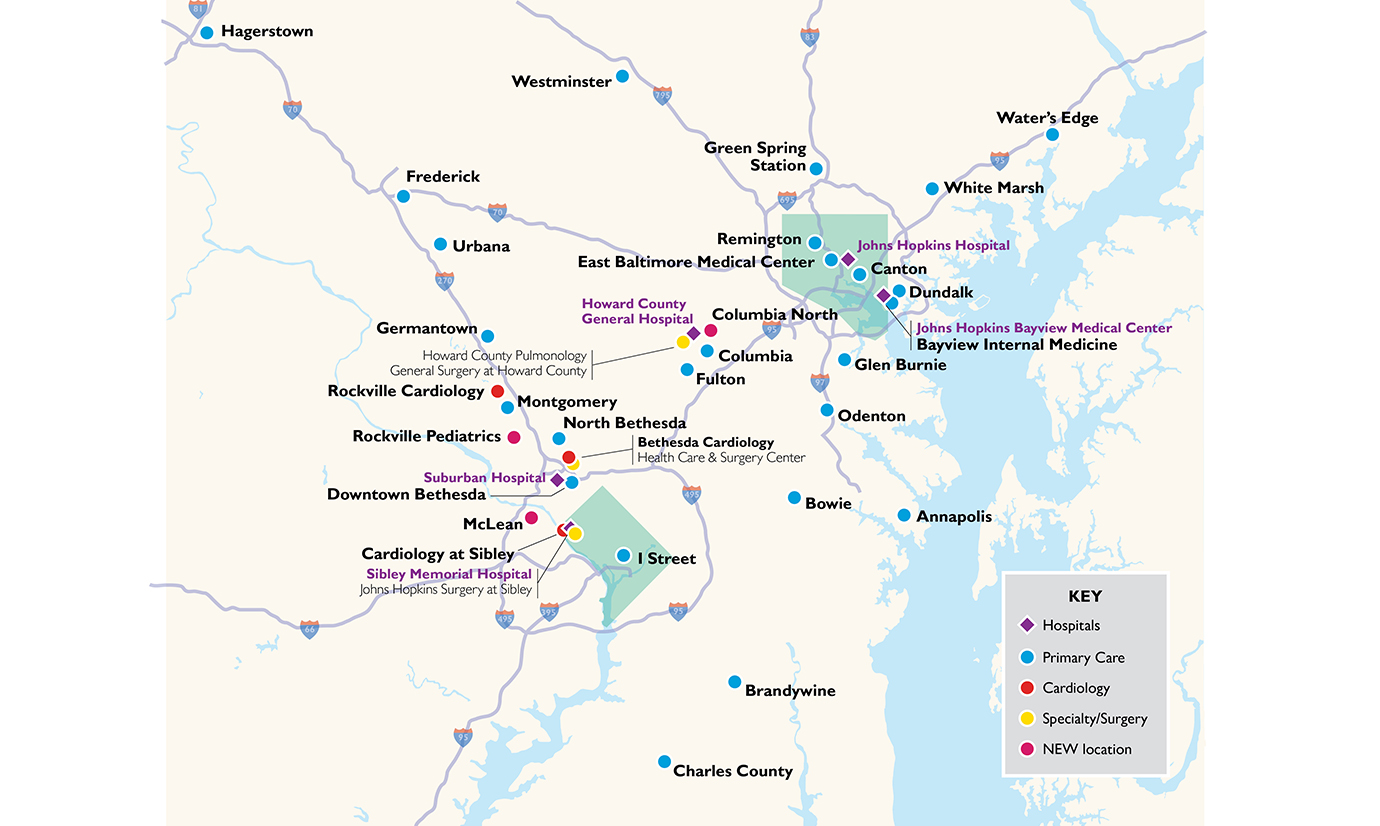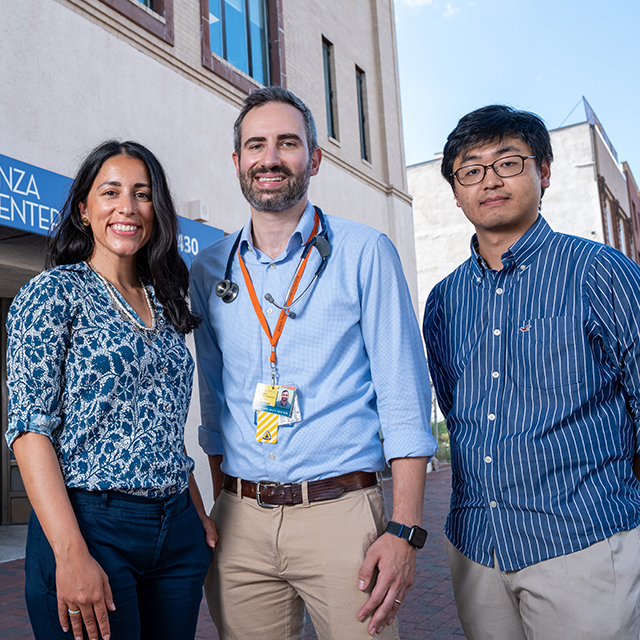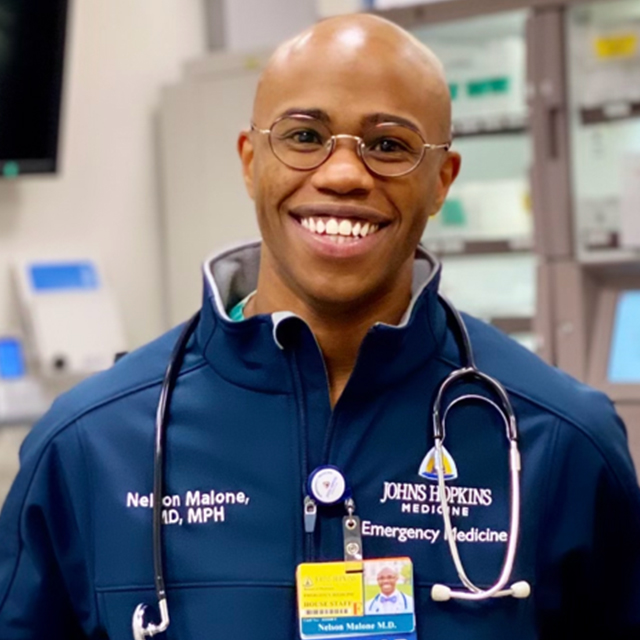When Nina Steigerwald was readying patient charts recently at the Johns Hopkins Community Physicians (JHCP) practice in Bethesda, Maryland, they noticed that a patient was scheduled for a cervical cancer screening and a prostate exam. When she arrived, the patient explained that she was a transgender woman and that she was having her first appointment for hormone therapy.
Nina — who identifies as nonbinary and queer, and who uses they/them and she/her pronouns — made sure the patient’s chart reflected this. Then, they updated the chart to note that only a prostate exam was needed, and that the patient preferred to be called only by her chosen name.
“Those small things, I feel like they define a patient’s experience, especially in such early parts of transitioning,” Nina says. “I want to make sure that every patient I interact with feels seen and heard when they come to me.”
The 27-year-old certified clinical medical assistant traces their empathy to their difficult experiences dealing with chronic illnesses and other health issues, with gender identity and, most recently, with the need to flee their hometown of Kharkiv, Ukraine — a city about 15 miles from the Russian border.
Now, more than a year after leaving war-torn Ukraine, Nina has settled in Silver Spring, Maryland, the hometown of their American spouse, Eric Steigerwald. Having completed the clinical medical assistant program at Montgomery College, which was Eric’s alma mater, Nina is three months into a new job at JHCP’s downtown Bethesda location. They work with certified registered nurse practitioner David Perez.
Josmary Sierra Rivera, clinical supervisor at the JHCP clinic, says Nina has become one of the best clinical medical assistants in the practice.
“Nina has a strong desire to help patients, families and colleagues, and is an excellent communicator with great cultural awareness,” Sierra Rivera says. “She is truly present with every patient.”
Nina takes the patient’s vital signs, reviews medications and allergies, and discusses the reason for the visit and concerns the patient may have. They also set up orders for laboratory tests, handle medication refill requests and make sure every detail of the visit is documented in the patient’s electronic medical record.
Leaving Home and Finding a New Career
Before the war, Nina, who speaks fluent English, worked in the computer science field while teaching English to older adults at a social services center. Additionally, they volunteered with a recycling center and a local LGBTQ pride organization. They also freelanced as an executive assistant while Eric was writing narratives for video games.
While monitoring the increasing tensions between Russia and Ukraine, the couple decided to leave Kharkiv temporarily and wait for things to settle down. Already engaged, they got married in their local municipal hall in January 2022, a month before the war began, and left for the Czech Republic.
“Then, on Feb. 24, that’s when we heard from my mom that the bombing started,” Nina says. “From then, the next couple of months were very intense in terms of trying to figure out how to settle all the affairs and how to help our family members.”
Using money they saved, the couple supported friends and family members while contemplating their next steps. As the situation in Ukraine deteriorated, the newlyweds decided to go to the United States and live with Eric’s parents in Silver Spring. After Nina received their visa and green card, the couple arrived in the U.S. on July 22, 2022.
Nina decided to make a career switch into health care, a field that would offer the human connection they missed in the world of computer science.
“I have a strong need for empathy and a strong need to feel like I’m making a positive impact,” they say.
On Eric’s suggestion, Nina signed up for the medical assistant program, which lasts about three months and consists of two lectures and four hours of clinical practice each week. The program finishes with a full-time, two-week externship, which Nina completed at JHCP’s Washington, D.C., location before starting the job in Bethesda.
“I learned a lot, not only about how to communicate with patients, but also how to communicate with the staff and your team to make sure that what you’re focusing on is patient care and that the patient always comes first,” they say.
Externship Program
Externship partnerships, such as the one with Montgomery College, serve as pipelines for JHCP to fill medical assistant vacancies.
“Specifically in primary care, the medical assistant is the heart and soul of the practice,” says Chris Rawlinson, director of education and nursing for JHCP. “Similar to nurses, these medical assistants know patients inside and out. It’s important to have skilled medical assistants in our practices as integral members of our interdisciplinary teams and to build those relationships that truly impact the care that our patients experience.”
Rawlinson centralized the externship program across JHCP when she joined the organization in 2020. The program was previously unstructured, and inclusion of externs had varied from practice to practice. Some considered hosting them as “busy work,” she says.
Through partnerships with a variety of colleges in Maryland, Rawlinson and JHCP have increased the number of externs coming to JHCP, and many have become full-time employees. Some of the newest externs came through Montgomery College’s refugee training center, which offers support through English classes, vocational training, scholarships and employment services.
In fiscal year 2022, JHCP hosted 24 externs, 11 of whom became employees. In fiscal year 2023, those numbers grew to 61 externs, and 32 were hired as medical assistants. Rawlinson and her team are forging new partnerships to expand the program, and she hopes that the program will continue to fill vacant positions and reduce turnover rates.

Above: There are now 52 JHCP practices, spreading from Frederick County to Harford County to Washington, D.C., and Northern Virginia to Charles County in Southern Maryland, and three-quarters have hosted externs.
Back to the Books
As Nina settles into their new career, the war at home hangs over their life in America. Three people they knew died — one was fighting with the Ukrainian army — and their family is still there. Nina’s mother, and aunts and uncles, have moved from Kharkiv to Tiachiv, a city in southwest Ukraine just north of the Romanian border — about as far from Russia as they can be. They supported their family financially for a year.
They are taking biology and bioengineering classes at Montgomery College, hoping to attend medical school and become a doctor. Although Nina has not decided what specialty to pursue, gender-affirming care is appealing, especially after working with patients who are nonbinary or transitioning.
“Knowing how it feels to be different and knowing how important it is to be seen in the smallest interactions — that’s what really drives me,” they say. “Working with [JHCP] gives me a lot of hope. It gives me the sense that I’m actually doing something that matters, and we can influence people’s lives and help them get on a better health care track.”



